Abstract
Ground blast-furnace slag is one of the waste products available in Ukraine and other countries. It is obtained at metallurgical enterprises in huge quantities and can be efficiently used for concrete production. The article is devoted to obtaining experimental-statistical models of the influence of technological factors that determine the composition of self-compacting concrete (SCC) based on ground blast-furnace slag and polycarboxylate superplasticizer on compressive strength, tensile strength, prismatic strength, elastic modulus and crack resistance. Analysis of the investigated factors’ influence on the specified SCC properties is carried out and positive influence of blast-furnace slag and superplasticizer simultaneous action on durability and deformation characteristics is studied. A design method of SCC composition design using the obtained mathematical models is developed. It allows for the consideration of a set of necessary parameters simultaneously. A numerical example is given.
1. Introduction
Applying effective plasticizers and superplasticizers in concrete compositions enable to obtain concrete mixtures with high workability (cast mixtures) and hardened concrete with high physical, mechanical and operational characteristics based on ordinary Portland cement and aggregates [1,2]. At the same time, along with obvious advantages, concrete mixtures with high workability have a number of disadvantages, such as loss of fluidity, delamination, slow hardening, etc. The effect of those disadvantages can be significantly reduced by using third-generation superplasticizers and highly dispersed silica-containing materials of man-made origin, especially silica fume [2,3].
Wide use of self-compacting concrete (SCC) in construction is quite attractive, but it is limited by the need to use highly active mineral admixtures and the lack of sufficient experimental basis for predicting its properties [3]. In turn, for proper structural design, data on deformability and crack resistance of such concrete are required, and the effect of its structural properties caused by high content of binders, active mineral admixtures and superplasticizers on structural behavior and durability should be investigated [4,5].
One of the widespread active mineral additives for concrete is ground domain granular slag [6]. Of all types of metallurgical slags used for producing construction materials, blast-furnace slag is the most widely used one. This is because blast-furnace slag has a chemical and mineralogical composition that is close to that of cement and has the ability to acquire hydraulic activity at rapid cooling [7].
Blast-furnace slag is formed in large quantities at metallurgical enterprises. It is an artificial silicate material formed during smelting metals from ore due to the high-temperature interaction of ore, fuel, floodplains and gaseous medium. For many years, a significant amount of blast-furnace slag has accumulated in dumps, occupied agricultural land and polluted the environment. Therefore, disposal of metallurgical slag is important for environmental protection and resource reuse worldwide.
SCC is usually characterized by high cement consumption [8], so the issue of efficient use of blast-furnace slag to replace part of cement, which is addressed in this study, is very important to improve the environmental friendliness of construction.
In order to use SCC in structural elements, the influence of technological factors on concrete deformability, crack resistance and behavior under loading is important. Development of proper methodology for predicting the SCC deformability at the concrete composition design stage is also relevant.
One of the most important and well-predictable concrete deformation characteristics is its modulus of elasticity. It is known [9] that ordinary and high-strength concrete modulus of elasticity closely correlates with its prismatic strength. Empirical dependences that interrelate those parameters have been proposed [10]. These dependences are included in various design codes. The empirical equations are often significantly different each from other by the equation form and also by coefficients, which vary in a rather wide range.
As known, due to the lower content of coarse aggregate, which creates a rigid frame, SCC has lower modulus-of-elasticity values [11]. For low-class concrete, the decrease in SCC modulus of elasticity is about 40% [12]. As the concrete class becomes higher, the difference between SCC modulus of elasticity and that of ordinary concrete decreases to 5%. It is obvious that various technological and structural factors cause significant changes in modulus of elasticity; therefore, it is difficult to find a close relationship, which could predict the SCC modulus of elasticity.
2. Research Aim, Scope and Novelty
In order to design composition of SCC with blast-furnace slag, taking into account a set of specified properties, it is important to obtain mathematical dependences allowing evaluation of technological and concrete composition factors’ impact on the required properties. The method of mathematical experiments planning [13,14] is effective to obtain such dependences. The method enables the receipt of regression equations by statistical processing of data obtained from the “active” experiment, i.e., the experiments are conducted according to a mathematically based scheme that helps to minimize the number of experimental points [15].
In order to identify the complex effect of active mineral additives and polycarboxylate-type superplasticizers on SCC strength and deformable properties in a wide range of strength classes, as well as to establish mathematical relationships between properties and technological factors, a planned experiment was conducted.
The novelty of this study is that based on the experimental results, mathematical models of strength and deformation characteristics of SCC based on blast-furnace slag are obtained. These models allow for a design of concrete composition that provides the required concrete characteristics at different hardening stages with minimum possible cement consumption.
3. Experimental Program
As variable factors were selected Portland cement consumption C, kg/m3 (X1), superplasticizer content SP, % (X2) and consumption of mineral additives (blast-furnace granulated slag) Sl, kg/m3 (X3). The concrete-mixture workability at the points of the experiment was maintained at the level of S5 (Slump—250–270 mm, which corresponds to the cone spread of 560–620 mm (F5 according to [16]). 204 cubic specimens of 100 mm × 100 mm × 100 mm and 48 prisms of 100 mm × 100 mm × 400 mm were prepared from the concrete mixture. Compressive strength (fcm, MPa), splitting tensile strength (fctm, MPa) and modulus of elasticity (Ecm were determined at 1 and 28 days. Mechanical properties of concrete (strengths of cubes and prisms) under a single short-term load were determined by standard methods [17].
For determining the strength of concrete cubic specimens, the experiment was performed according to a three-level three-factor plan B3 [15] to obtain mathematical polynomial models of the form:
where Y is the output parameter, X1…X3 are variables, b0…b23 are the equation coefficients.
Y = b0 + b1X1 + b2X2 + b3X3 + b11X12 + b22X22 + b33X32 + b12X1X2 + b13X1X3 + b23X2X3,
Investigation of deformation characteristics was carried out in accordance with the two-level plan of the three-factor plan [15]. The type of mathematical model is:
Y = b0 + b1X1 + b2X2 + b3X3 + b12X1X2 + b13X1X3 + b23X2X3,
The planning conditions are given in Table 1.

Table 1.
Experiment-planning conditions.
The following materials were used in the research: Portland cement CEM I 42.5 (Table 2), sand with Mf = 2.0, locally available granite crushed-stone fraction 5–20 mm, blast-furnace granular slag, polycarboxylate-type superplasticizer PCE50 (LLC UA-Chemical, Ukraine). The experiment-planning matrix and the concrete composition at the experimental points are given in Table 3.

Table 2.
Characteristics of Portland cement and blast-furnace granular slag.

Table 3.
The results of determining the experiment output parameters.
By statistical analysis of the experimental results (Table 3), mathematical models of the output parameters, as well as correlations between individual initial parameters were obtained. The coefficients of mathematical models are given in Table 4.

Table 4.
Coefficients of experimental-statistical models of output parameters.
4. Results and Discussion
SCC with organic-mineral modifier, which includes polycarboxylate SP and blast-furnace granulated slag, had compressive strength in the range from 3.6 to 51 MPa after 1 day of hardening. As expected, factors X1 (cement consumption) and X2 (SP content), which cause a significant decrease in W/C, contribute to a significant increase in strength at 1 day.
The optimal content of the SP additive is significantly related to the cement consumption—at a minimum content of C just 0.5% of SP is enough to maximize the strength; at a maximum cement consumption the optimal SP content is 0.8–1.1. With the increase in the slag content, the optimal content of the additive and its effectiveness slightly decreases (Figure 1).

Figure 1.
Dependence of compressive strength at 1 day on the blast-furnace-slag content.
Increasing the blast-furnace-slag content (X3) mostly reduces the strength at 1 day of SCC hardening by 40–70%. As known [18], blast-furnace slag reacts rather slowly with cement-hydration products (primarily with portlandite), so a greater effect should be expected at longer hardening duration. At low cement consumptions, blast-furnace slag plays a positive role; there is an increase in fcm1 by 20–25%.
The concrete classes by strength at 28 days that were investigated in the frame of the present research ranged from C8/10 to C 70/85. In general, the tendencies of the factors affect, detected for strength at 1 day, are similar to those at 28 days (Table 4, Figure 2). It should be mentioned that the efficiency of factor X3 (blast-furnace-slag consumption) becomes higher. The extreme influence of blast-furnace-slag content becomes more noticeable, which makes it possible to determine its optimal amount from the position of achieving maximum strength: at a cement consumption of 600 kg/m3 the optimal slag content from the strength viewpoint is 40–50 kg/m3 and it is 120–150 kg/m3 at cement consumption of 200 kg/m3.
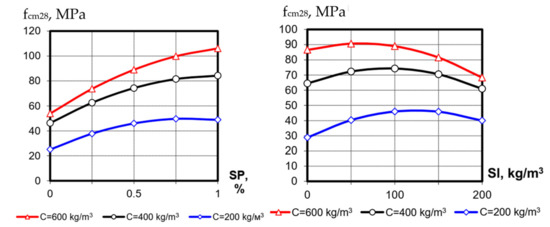
Figure 2.
The influence of SP and blast-furnace-slag content at different levels of cement consumption on the SCC compression strength at 28 days (the value of the third factor in the graphs is at the average level (Table 1)).
The values of splitting tensile strength at the 1st day (fctm1) varied from 0.4 to 5.44 MPa and at 28 days (fctm28), from 1.35 to 8.9 MPa. Following the mathematical models, the nature of the variable factors’ influence on splitting tensile strength is almost the same as for compressive one (Figure 3 and Figure 4). Only the more noticeable positive effect of blast-furnace-slag content on fctm at 28 days is noteworthy, especially at low cement consumption. As known [19], splitting tensile strength is mainly determined by the cement stone strength and its amount in concrete, so at low cement consumption, such an effect of increasing the total amount of binder with a long interaction of active additives and cement is expected.
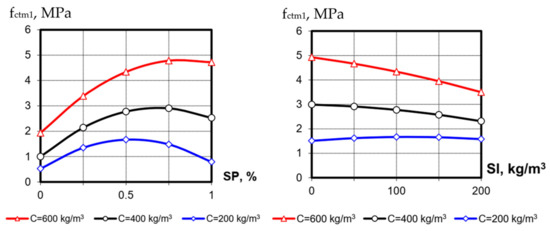
Figure 3.
The influence of SP content and blast-furnace-slag content at different levels of cement consumption on SCC splitting tensile strength at 1 day (the value of the third factor on the graphs is at the average level (Table 1)).
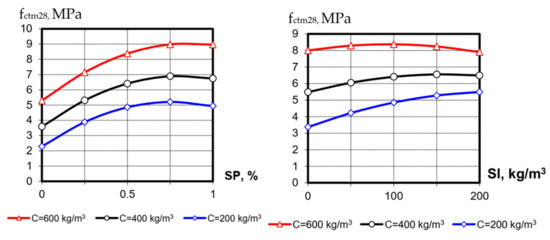
Figure 4.
The influence of SP and blast-furnace-slag content at different levels of cement consumption on SCC splitting tensile strength at 28 days (the value of the third factor in the graphs is at the average level (Table 1)).
One of the criteria for crack resistance of concrete is the ratio between compressive and tensile strengths fcm/fctm. A decrease in this ratio indicates an increase in concrete resistance to cracking [9]. Using the calculated values from Table 3, a mathematical model of the ratio fcm/fctm at 28th days is obtained (Table 4). The main graphical dependences of the crack resistance index on the investigated factors are shown in Figure 5. The value of this criterion according to experimental data is in the range from 7.4 to 13.8. Analysis of the model shows that the achievement of the minimum criterion values is greatly facilitated by the increase in the blast-furnace-slag content (factor X3) at a minimum cement consumption (X1) (Figure 5). According to the available results [9], during hardening of cements with high slag content, a significant amount of low-basic calcium hydrosilicates is formed. As known [20], due to their nature these hydrosilicates are more deformable compared to highly basic calcium hydrosilicates, formed by hydration of Portland cement clinker.
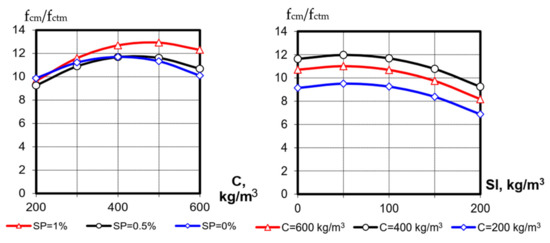
Figure 5.
Influence of varied factors on the crack-resistance criterion fcm/fctm.
Prismatic strength and modulus of deformation of SCC with organic-mineral modifier were studied by testing 100 mm × 100 mm × 400 mm prisms. The influence of the same three factors (cement consumption (X1) C, kg/m3, superplasticizer content (X2) SP, %, blast-furnace granular-slag consumption (X3) Sl, %) was studied according to the linear plan of the full factorial experiment [15]. The coefficients of the mathematical model are given in Table 4.
The prismatic strength after one day of hardening ranged from 2 to 32 MPa, which corresponded to 78% of concrete cubes’ strength at the same age. The highest influence on the prismatic strength is caused by factors X1 (C) and X2 (SP), which first of all cause a decrease in W/C in transition from the lower to the upper level (Figure 6). Factor X3 (content of blast-furnace granulated slag) has little effect on the prismatic strength after one day of hardening.
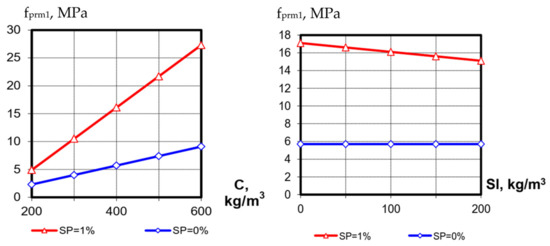
Figure 6.
Influence of varied factors on SCC prismatic strength at 1 day (the value of the third factor on the graphs is at the average level (Table 1)).
After 28 days of hardening (Figure 7) interaction of factors X3 (slag content) with X1 (cement consumption) becomes more noticeable: for low cement consumption, an increase in slag content has a positive effect on concrete prismatic strength, while at high cement consumption the same increase in slag consumption causes a decrease in strength. As known [9], concrete deformations play a greater role in concrete prisms’ destruction (compared to the test of cubes), so the prismatic strength can be considered more as a concrete-deformation characteristic. The positive effect of the cement slag component at high values of W/C also confirms the structural role of low-basic calcium hydrosilicates, which are formed to a higher extent than in clinker cements.
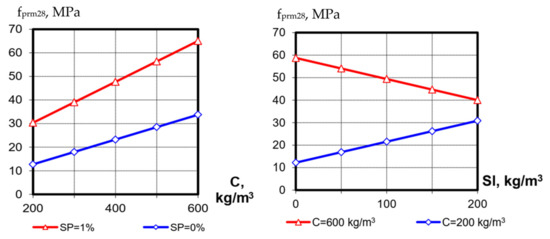
Figure 7.
Influence of varied factors on SCC prismatic strength at 28 days (the value of the third factor on the graphs is at the average level (Table 1)).
The influence of other factors (cement consumption and SP content) on the prismatic strength at 28 days is similar to that after 1 day of hardening. The strength varies from 11 to 85 MPa. The mean value of the ratio between cubic and prismatic strength at 28 days is like after one day of hardening: 78%. The correlation between these concrete characteristics is shown in Figure 8.
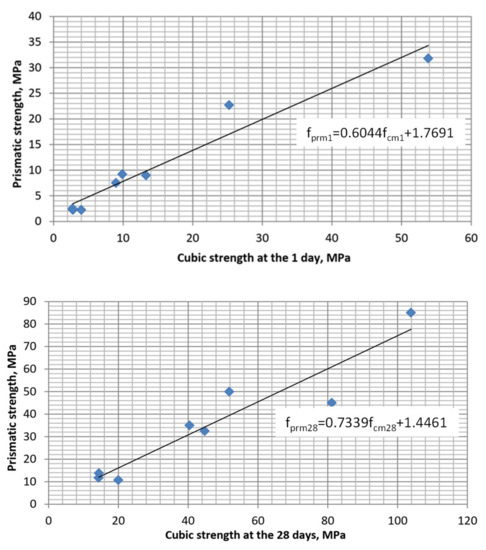
Figure 8.
Correlation between the SCC cubic and prismatic strength.
The values of concrete modulus of elasticity at the first day were in the range from 10,000 to 27,000 MPa, at the 28th day—from 19,000 to 50,000 MPa. Analyzing the mathematical models, it should be noted that all three investigated factors significantly affect the SCC modulus of elasticity. The interactions between these factors are also significant.
At transition of factors X1 (C, kg/m3) and X2 (SP, %) from the lower level to the upper one the SCC modulus of elasticity increases on average from 10,000–12,000 to 20,000–26,000 MPa at 1 day and from 20,000–30,000 to 40,000–50,000 MPa at 28 days. The positive interaction coefficient of these factors (b12, Table 4) indicates a significant increase in the modulus of elasticity values with a simultaneous increase in cement consumption and superplasticizer content, both after 1 day and after 28 days of hardening. Factor X3 (slag consumption) on average has less effect on the modulus of elasticity than X1 and X2, but its effect is significantly enhanced by the simultaneous influence of other factors. At low cement consumption (C = 200 kg/m3) the increase in slag consumption increases Epr by 1.5–1.7 times both at early hardening stages and at 28 days; however, at high cement consumption the same factor causes a significant reduction in SCC modulus of elasticity (Figure 9 and Figure 10).
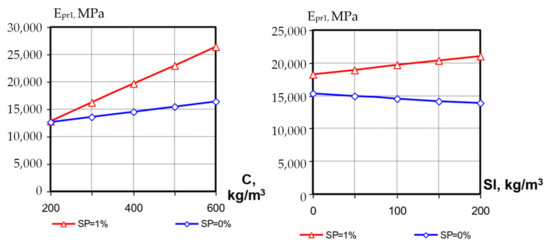
Figure 9.
Influence of cement, slag and SP contents on SCC modulus of elasticity at 1 day.

Figure 10.
Influence of cement, slag and SP contents on SCC modulus of elasticity at 28 days.
The action of superplasticizer has a significant influence on the change of SCC modulus of elasticity vs. the blast-furnace-slag content; if in compositions without SP the positive effect of factor X3 is manifested only at low cement consumption, then the diluting and water-reducing action of polycarboxylate SP contributes to the positive effect of the slag component, and at higher cement costs it is probably leveling the significant increase in concrete-mixture water demand and causing formation of a denser concrete structure.
For predicting the concrete modulus of elasticity under loading at the age of τ days the most used dependencies have the following form:
where Rτ is compressive strength of concrete cubes after a certain curing duration (τ); Em and S are empirical constants. Modern codes for structural design recommend the following values: Em = 52,000; S = 23 [9].
According to the European Concrete Committee recommendation [9], the following dependence should be used:
where C = 1900, γ = 0.5.
Different modifications of Equation (4) and coefficient values were proposed [10]. According to ACI-318-83 [21], concrete modulus of elasticity can be calculated as follows:
For high-strength concrete, the American Concrete Association has proposed a different equation [11]:
Deformability characteristics of concrete with modifying additives differ from the usual one. Elastic properties of modified concrete, including SCC, increase 1.4 times, and plastic ones decrease twice [10]. For modified concrete, the following dependence was obtained:
This dependence is fundamentally similar to Equations (3) and (4) and differs by a refined coefficient for modified high-strength concrete. The difference between the values of E calculated by Equations (3)–(7) increases (up to 35%) as the concrete strength increases [9].
Based on the obtained data, the dependence between the modulus of elasticity of self-compacting concrete with a multifunctional modifier containing blast-furnace slag and superplasticizer was approximated (Figure 11 and Figure 12). The obtained equations have the following form:
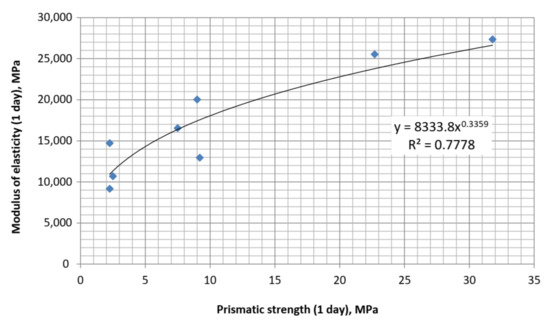
Figure 11.
Correlation between the modulus of elasticity and prismatic strength at 1 day.
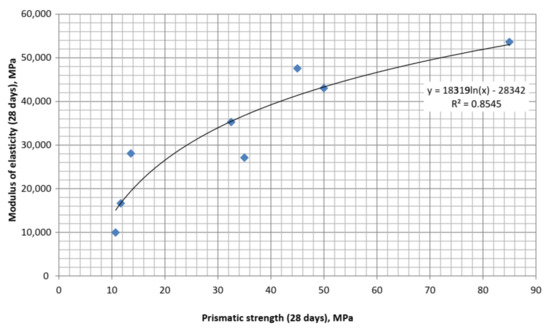
Figure 12.
Correlation between the modulus of elasticity and prismatic strength at 28 days.
- -
- after 1 day of hardening:
- -
- after 28 days of hardening:
Table 5 shows the modulus of elasticity values, calculated by empirical Equations (1), (3)–(5) and (9) by strength indicators, as well as experimental values obtained for SCC. As it can be seen from Table 5, the average value of errors for calculations by all equations varies within a fairly narrow range: 18–35%. Significant differences in the errors obtained for calculations according to each of the equations (see Table 5 vertically) allows one to suggest that along with close correlation between strength and modulus of elasticity, which is noted by many authors [9,11,22,23], this indicator is significantly dependent on concrete qualitative composition, and especially the content of mineral and chemical additives that modify the cement stone structure. Comparing the data in Table 5, it becomes obvious that using correlations between strength and modulus of elasticity is appropriate only for approximate establishment of the required deformation characteristics, for example, for the design of reinforced concrete structures.

Table 5.
Comparison of SCC modulus of elasticity values calculated using different empirical dependences with experimental data.
A method of creating and using multifactor dependences obtained, for example, by mathematical experiments planning has a higher resolution to perform tasks of predicting concrete properties at the composition design stage. The obtained experimental-statistical models with coefficients given in Table 4 enable us to predict a set of strength and deformation properties at certain values of the investigated factors: consumptions of cement, blast-furnace slag and superplasticizer. The use of mathematical optimization methods [16] and the corresponding software allows one to find the values of the above-mentioned factors that provide the necessary properties with minimal resource consumption [24].
Numerical example. Calculate composition of high-strength SCC (Slump—250–270 mm) using ground blast-furnace slag with a specific surface area of 270 m2/kg and polycarboxylate superplasticizer. The required indicators are that concrete class C40/50 (cubic strength at 28 days at least 64.3 MPa), cubic strength and modulus of elasticity at 1 day must meet the normative indicators for class C12/15: at least 19.3 MPa and 27,000 MPa, respectively.
Characteristics of raw materials: true densities of cement, slag, sand and crushed stone are 3100 kg/m3, 2900 kg/m3, 2650 kg/m3, 2700 kg/m3. The part of crushed stone in the SCC should not exceed 0.35.
5. Solution
- According to experimental statistical models of fcm1, fcm28, Epr1 (see Table 4) using the methods of mathematical optimization [25], find the values of factors (consumptions of cement and slag, and superplasticizer content) that provide required indicators and satisfying the condition that the total cost of these components is minimal (Table 6). For calculations purposes, the following cost of components was assumed: cement—88 EUR/t, ground blast-furnace slag—27 EUR/t, superplasticizer—2.85 EUR/t. These cost values were taken on the basis of market prices in Ukraine on 10 April 2021.

Table 6.
Optimization results for mathematical models.
Table 6.
Optimization results for mathematical models.
| Indicator | Units | Value |
|---|---|---|
| Optimal values of factors | ||
| Cement consumption per 1 m3 | kg | 492 |
| Slag consumption per 1 m3 | kg | 200 |
| SP content | % | 1 |
| Concrete quality indicators | ||
| Normative compression strength at 1 day | MPa | 19.3 |
| Calculated * compression strength at 1 day | MPa | 21.2 |
| Normative value of modulus of elasticity at 1 day | MPa | 23,000 |
| Calculated * value of modulus of elasticity at 1 day | MPa | 23,000 |
| Normative compression strength at 28 days | MPa | 64.3 |
| Calculated * compression strength at 28 days | MPa | 81.0 |
* The values of indicators calculated according to mathematical models for corresponding optimal values of factors (cement, slag and SP contents).
- 2.
- According to the mathematical model of W/C (see Table 4), calculate the value of W/C at the optimal factors values and concrete-mix water demand:
W/C = 0.26, W = C·(W/C) = 492·0.26 = 126 l/m3
- 3.
- Find the crushed stone consumption from the condition that its volume should be 0.35 of concrete volume:
- 4.
- Find the sand consumption:
- 5.
- Find the superplasticizer content:
Concrete composition per 1 m3 is:
Cement—492 kg; water—128 l; SP—4.92 kg; slag—200 kg; sand—780 kg; crushed stone—945 kg. A spreadsheet with the calculation performed can be viewed in Supplementary Materials (Table S1: Numerical example).
When using raw materials that differ from those used in the obtaining models (Table 4), it is effective to use the method of experimental-calculation adaptation [26], allowing to adjust the values of models’ coefficients considering laboratory control data of the required indicators.
6. Conclusions
The properties of self-compacting concrete with organic-mineral modifier, including blast-furnace granulated slag and polycarboxylate-type superplasticizer, have been studied. Mathematical models of cubic and prismatic strength, as well as modulus of elasticity at different concrete ages were obtained.
The combined action of blast-furnace slag and polycarboxylate superplasticizer contributes to an increase in the self-compacting concrete elasticity modulus by 1.5–1.7 times. A method for composition design of self-compacting concrete using blast-furnace slag and polycarboxylate superplasticizer is proposed. The method allows for the consideration of the strength of prisms and also the influence of technological factors that characterize the SCC composition when determining its modulus of elasticity.
The use of the obtained mathematical models enables the optimization of the SCC composition in order to provide the necessary strength and deformability characteristics at minimum cost of the final product.
Supplementary Materials
The following supporting information can be downloaded at: https://www.mdpi.com/article/10.3390/ma15124110/s1, Table S1: Numerical example.
Author Contributions
Conceptualization, V.Z. and L.D.; methodology, V.Z. and D.K.; software, D.K. and Y.R.; validation, V.Z., L.D. and Y.R.; formal analysis, V.Z. and D.K.; investigation, V.Z.; resources, Y.R.; data curation, V.Z.; writing—original draft preparation, V.Z. and L.D.; writing—review and editing, Y.R.; visualization, V.Z.; supervision, L.D.; project administration, Y.R.; funding acquisition, Y.R. All authors have read and agreed to the published version of the manuscript.
Funding
This research received no external funding.
Conflicts of Interest
The authors declare no conflict of interest.
References
- Okamura, H.; Ozawa, K.; Ouchi, M. Self-compacting concrete. Struct. Concr. 2000, 1, 3–17. [Google Scholar] [CrossRef]
- Ohta, A.; Sugiyama, T.; Tanaka, Y. Fluidizing Mechanism and Applications of Polycarboxylate-Based Superplasticizers. In Proceedings of the SP-173: The Fifth CANMET/ACI International Conference, Rome, Italy, 7–10 October 1997; pp. 359–378. [Google Scholar]
- Long, G.; Gao, Y.; Xie, Y. Designing more sustainable and greener self-compacting concrete. Constr. Build. Mater. 2015, 84, 301–306. [Google Scholar] [CrossRef]
- Khudhair, J.; Chkheiwer, A. Structural Behavior of Reinforced Self Compacting Concrete. Al-Muthanna J. Eng. Sci. 2016, 3, 1–11. [Google Scholar]
- Kolanjinathan, P.; Perumal, P. An Experimental Investigation and Comparison of Structural Behavior of RCC Columns and Reinforced Fly Ash Added Self Compacting Concrete Columns. Eur. J. Sci. Res. 2011, 61, 131–143. [Google Scholar]
- Esping, O.; Löfgren, I. Investigation of early age deformation in self-compacting concrete. In Proceedings of the 2nd International Symposium on Advances in Concrete through Science and Engineering, Quebec City, QC, Canada, 11–13 September 2006; pp. 1–16. [Google Scholar] [CrossRef]
- Yu, J. Research on the Mechanical Properties of Self-compacting Waste Rubberised Aggregate Concrete. In Proceedings of the 2016 International Conference on Civil, Transportation and Environment, Guangzhou, China, 30–31 January 2016; Atlantis Press: Amsterdam, The Netherlands, 2016; pp. 88–92. [Google Scholar] [CrossRef]
- Awal, A.; Rahman, M.M. Deformation behaviour of self-compacting concrete containing high volume palm oil fuel ash. In Proceedings of the 9th Asia Pacific Structural Engineering and Construction Conference (APSEC 2015) & 8th Asean Civil Engineering Conference (ACEC 2015), Kuala Lumpur, Malaysia, 3–5 November 2015; pp. 1–6. [Google Scholar]
- Dvorkin, L.I.; Dvorkin, O.L. Bases of Concrete Science; Stroybeton: Saint Petersburg, Russia, 2006; 690. (In Russian) [Google Scholar]
- Yu, M.; Bazhenov. Modified High Quality Concrete; Association of Civil Engineering Education: Moscow, Russia, 2006; 368. (In Russian) [Google Scholar]
- Safiuddin, M.; Jumaat, M. Fresh properties of self-consolidating concrete incorporating palm oil fuel ash as a supplementary cementing material. Chiang Mai J. Sci. 2011, 38, 389–404. [Google Scholar]
- Domone, P. A review of the hardened mechanical properties of self-compacting concrete. Cem. Concr. Compos. 2007, 29, 1–12. [Google Scholar] [CrossRef]
- Montgomery, D.C. Design and Analysis of Experiments, 5th ed.; Wiley: Hoboken, NJ, USA, 2000; 688p. [Google Scholar]
- Box, G.E.P.; Hunter, J.S.; Hunter, W.G. Statistics for Experimenters: Design, Discovery, and Innovation, 2nd ed.; Wiley: Hoboken, NJ, USA, 2005; 672p. [Google Scholar]
- Dvorkin, L.; Dvorkin, O.; Ribakov, Y. Mathematical Experiments Planning in Concrete Technology; Nova Science Publishers: Hauppauge, NY, USA, 2012; 175p. [Google Scholar]
- EN 206-1:2000; Concrete—Part 1: Specification, Performance, Production and Conformity. CEN: Brussels, Belgium.
- EN 12390-1:2021; Testing Hardened Concrete—Part 1: Shape, Dimensions and Other Requirements for Specimens and Moulds. CEN: Brussels, Belgium.
- Lea’s Chemistry of Cement and Concrete, 4th ed.; Hewlett, P., Ed.; Butterworth Heinemann: Oxford, UK, 2003; 1092p, p. 1092. [Google Scholar]
- Neville, A.M. Properties of Concrete, 4th ed.; Wiley & Sons: New York, NY, USA, 1996; 844p. [Google Scholar]
- Topçu, I.B. High-volume ground granulated blast furnace slag (GGBFS) concrete. Eco-Effic. Concr. 2013, 218–240. [Google Scholar] [CrossRef]
- ACI 318-19; Building Code Requirements for Structural Concrete. American Concrete Institute: Farmington Hills, MI, USA, 2019.
- Batrakov, B.G. Modified Concrete; Stroyizdat: Moscow, Russia, 1998; 768p. (In Russian) [Google Scholar]
- Sviridov, N.V.; Kovalenko, M.G. Concrete based on ordinary cement with strength of 150 MPa. Beton Zhelezobeton 1990, 2, 7–9. (In Russian) [Google Scholar]
- Dvorkin, L.; Bordiuzhenko, O.; Zhitkovsky, V.; Marchuk, V. Mathematical modeling of steel fiber reinforced concrete properties and selecting its effective composition. IOP Conf. Ser. Mater. Sci. Eng. 2019, 708, 012085. [Google Scholar] [CrossRef]
- Kuneva, V.; Milev, M.; Gocheva, M. Modeling the transportation assesment with MS excel solver. AIP Conf. Proc. 2021, 2333, 150005. [Google Scholar] [CrossRef]
- Dvorkin, L.; Dvorkin, O.; Ribakov, Y. Multi-Parametric Concrete Compositions Design; Nova Science Pub Inc.: New York, NY, USA, 2013; 233p. [Google Scholar]
Publisher’s Note: MDPI stays neutral with regard to jurisdictional claims in published maps and institutional affiliations. |
© 2022 by the authors. Licensee MDPI, Basel, Switzerland. This article is an open access article distributed under the terms and conditions of the Creative Commons Attribution (CC BY) license (https://creativecommons.org/licenses/by/4.0/).